
Swimming is the self-propulsion of a person through water, or other liquid, usually for recreation, sport, exercise, or survival. Locomotion is achieved through coordinated movement of the limbs and the body to achieve hydrodynamic thrust that results in directional motion. Humans can hold their breath underwater and undertake rudimentary locomotive swimming within weeks of birth, as a survival response.
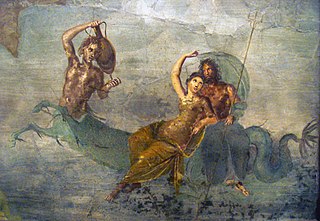
Neptune is the god of freshwater and the sea in Roman religion. He is the counterpart of the Greek god Poseidon. In the Greek tradition, he is a brother of Jupiter and Pluto; the brothers preside over the realms of heaven, the earthly world, and the seas. Salacia is his wife.
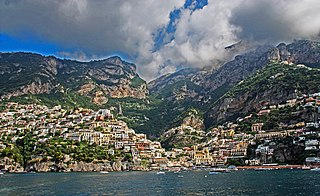
Positano is a village and comune on the Amalfi Coast, in Campania, Italy, mainly in an enclave in the hills leading down to the coast.

Ischia is a volcanic island in the Tyrrhenian Sea. It lies at the northern end of the Gulf of Naples, about 30 km (19 mi) from Naples. It is the largest of the Phlegrean Islands. Roughly trapezoidal in shape, it measures approximately 10 km (6 mi) east to west and 7 km (4 mi) north to south and has about 34 km (21 mi) of coastline and a surface area of 46.3 km2 (17.9 sq mi). It is almost entirely mountainous; the highest peak is Mount Epomeo, at 788 m (2,585 ft). The island is very densely populated, with 62,000 residents.

Mangalia, ancient Callatis, is a city and a port on the coast of the Black Sea in the south-east of Constanța County, Northern Dobruja, Romania.

Ponza is the largest island of the Italian Pontine Islands archipelago, located 33 km (21 mi) south of Cape Circeo in the Tyrrhenian Sea. It is also the name of the commune of the island, a part of the province of Latina in the Lazio region.

Pantelleria, the ancient Cossyra or Cossura, is an Italian island and comune in the Strait of Sicily in the Mediterranean Sea, 100 kilometres southwest of Sicily and 60 km (30 nmi) east of the Tunisian coast. On clear days Tunisia is visible from the island. Administratively Pantelleria's comune belongs to the Sicilian province of Trapani.

Ventotene is one of the Pontine Islands in the Tyrrhenian Sea, 46 kilometres off the coast of Gaeta right at the border between Lazio and Campania, Italy. The municipality of Ventotene, of the province of Latina (Lazio) had 708 permanent residents as of 2008.

The Gulf of Naples, also called the Bay of Naples, is a roughly 15-kilometer-wide (9.3 mi) gulf located along the south-western coast of Italy. It opens to the west into the Mediterranean Sea. It is bordered on the north by the cities of Naples and Pozzuoli, on the east by Mount Vesuvius, and on the south by the Sorrento Peninsula and the main town of the peninsula, Sorrento. The Peninsula separates the Gulf of Naples from the Gulf of Salerno, which includes the Amalfi Coast.
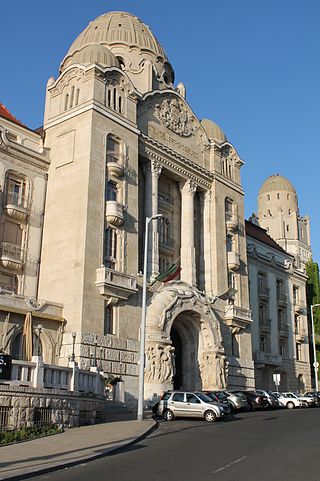
Part of the famous Hotel Gellért in Buda, the Gellért Thermal Baths and Swimming Pool, also known simply as the Gellért Baths, is a bath complex in Budapest in Hungary.

Barcola is a maritime neighbourhood of Trieste, Italy. It is a popular tourist place with beaches and long promenades, near the Habsburg-established Miramare Castle.

Fiuggi is a comune (municipality) in the province of Frosinone in the region of Lazio in central Italy. The town of Fiuggi became famous for its Acqua di Fiuggi which flows from its natural springs and mountains. The water has been used in Italy since as early as the 14th century and is famous for its purported healing properties.

Vieste is a town, comune and former Catholic bishopric in the province of Foggia, in the Apulia region of southeast Italy. A marine resort in Gargano, Vieste has received Blue Flags for the purity of its waters from the Foundation for Environmental Education. The area covered by the comune is included in the Gargano National Park.

Waiwera Hot Pools is a hot springs system located in the small coastal village of Waiwera, just north of Auckland, New Zealand. They were known to the Māori people for centuries before being developed. In the 1960s and 70s overproduction and overpumping of the geothermal aquifer led to significant loss of pressure and desiccation of the springs in the late 1970. A decade later the thermal springs began to recover, although the system has not returned to the former artesian conditions.

Licola is an area in the province of Naples which takes its name from Lago dei Follicoli, a lake which formerly occupied most of the area. The current population of Licola ranges between 4,000 and 5,000. Licola is a strip of land facing the sea, and is roughly three kilometers by ten kilometers in size. It begins at the foot of Mount Cuma and ends in Marina di Varcaturo.
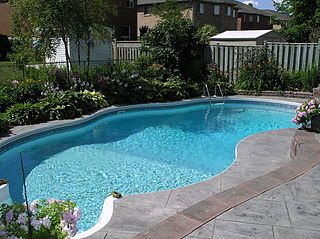
A swimming pool, swimming bath, wading pool, paddling pool, or simply pool, is a structure designed to hold water to enable swimming or other leisure activities. Pools can be built into the ground or built above ground, and may be found as a feature aboard ocean-liners and cruise ships. In-ground pools are most commonly constructed from materials such as concrete, natural stone, metal, plastic, or fiberglass, and can be of a custom size and shape or built to a standardized size, the largest of which is the Olympic-size swimming pool.
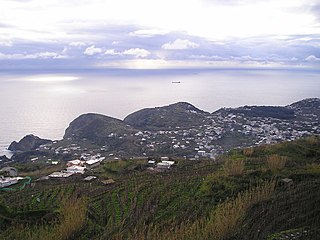
Panza(sometimes Panza d'Ischia) is a small town of 7,000 inhabitants on the island of Ischia, Italy. It is a hamlet (frazione) of the municipality of Forio.

The Lukács Thermal Bath is a historic indoor/outdoor thermal bath spa in Budapest, Hungary, heated by natural hot springs. All pools and four saunas can be used by all guests except for the optional area of the sauna world, which contains five more saunas, ice cooling pool, igloo and heated roman bench. There are also sauna nights on Fridays from 20:00 to 02:00.

Jacques Etienne Chevalley de Rivaz was a Swiss-born physician who spent his career in Naples and the Island of Ischia. He was the founder of a famous sanatorium on Ischia and also wrote several works on the geography, archeology, flora and fauna of the island. For his services to Naples during the cholera epidemic of 1836–37, he was awarded a gold medal by King Ferdinand II and citizenship of the Kingdom of the Two Sicilies. Chevalley de Rivaz was born in Vevey, Switzerland and died in Casamicciola, Italy at the age of 62.
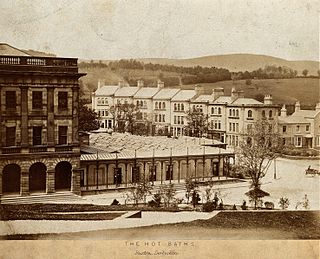
The Buxton Baths using natural thermal spring water are in Buxton, Derbyshire, England. The baths date back to Roman times and were the basis for developing Buxton as a Georgian and Victorian spa town. The present buildings of the Thermal Baths and the Natural Mineral Baths were opened in the 1850s. They are positioned either side of the Buxton Crescent at the foot of The Slopes in the town's Central Conservation Area. They are both Grade II listed buildings designed by Henry Currey, architect for the 7th Duke of Devonshire.



















